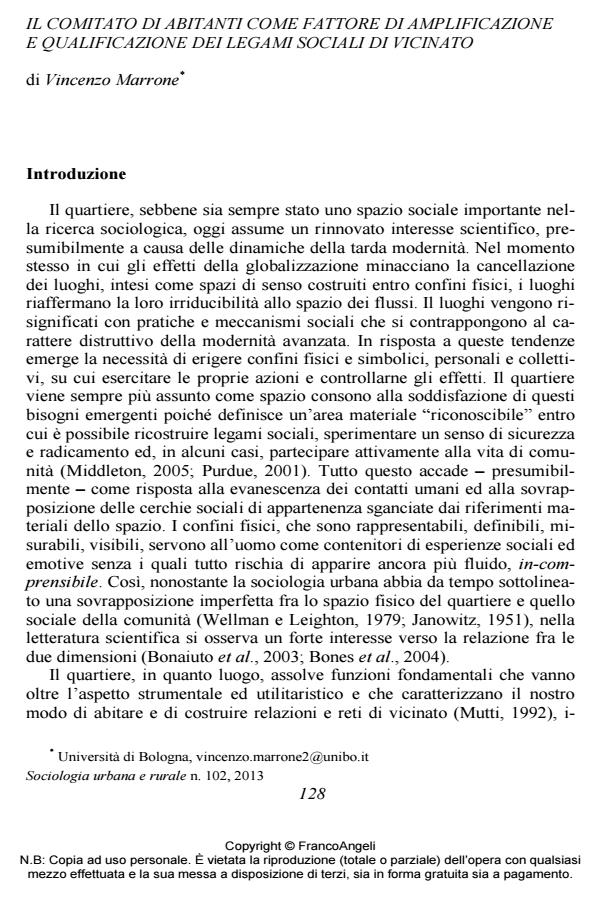The Role of the Neighborhood Committee to the Social Relationship and Sense of Security Perception
Journal title SOCIOLOGIA URBANA E RURALE
Author/s Vincenzo Marrone
Publishing Year 2013 Issue 2013/102
Language Italian Pages 15 P. 128-142 File size 452 KB
DOI 10.3280/SUR2013-102009
DOI is like a bar code for intellectual property: to have more infomation
click here
Below, you can see the article first page
If you want to buy this article in PDF format, you can do it, following the instructions to buy download credits

FrancoAngeli is member of Publishers International Linking Association, Inc (PILA), a not-for-profit association which run the CrossRef service enabling links to and from online scholarly content.
In the last decades some urban and architectural planning theories, as the new urbanism, have been focusing on the sense of community, security and social capital achievement starting from the design of housing and neighborhood solutions. The paper focuses on a comparative analysis between two similar planned neighbourhoods built on the new urbanism principles. The research findings show that the social dynamics and the sense of security perception are associated to the inhabitant committee presence more than the architectural and urban form.
Keywords: Neighborhood Attachment, New Urbanism, Neighborhood Committee, Sense of Security, Social Cohesion, Mixed Method
- Putnam R. (2000). Bowling Alone: the Collapse and Revival of American Community. New York: Simon & Schuster.
- Rosenblatt T., Cheshire L., Lawrence G. (2009). Social Interaction and Sense of Community in a Master Planned Community. Housing, Theory and Society, 2.
- DOI: 10.1080/1403609070186248
- Sampson R.J. (2011). Great American city: Chicago and the enduring neighborhood effect. Chicago: The university of Chicago.
- Sander T.H. (2002). Social Capital and New Urbanism: Leading a Civic Horse to Water?. National Civic Review, 3. DOI: 10.1002/ncr.9130
- Soja E.W. (2007). Dopo la metropoli: per una critica della geografia urbana e regionale. Bologna: Patron.
- Talen E. (2002). The Social Goals of New Urbanism, Housing Policy Debate, 1.
- DOI: 10.1080/10511482.2002.952143
- Talen E. (1999). Sense of community and neighbourhood form: An assessment of the social doctrine of new urbanism, Urban Studies, 8. DOI: 10.1080/004209899303
- Wellman B., Leighton B. (1979). Networks, Neighborhoods and Communities. Urban Affairs Quarterly, 3. DOI: 10.1177/10780874790140030
- Bohl C. (2000). New Urbanism and the City: Potential Applications and Implications for Distressed Inner-City Neighborhoods. Housing Policy Debate, 4. DOI: 10.1080/10511482.2000.952138
- BorliniB., Memo F. (2008). Il quartiere nella città contemporanea. Milano: Mondadori.
- Brown B.B., Cropper V.L. (2001). “New Urban and Standard Suburban Subdivisions: Evaluating Psychological and Social Goals.” APA Journal, 4. DOI: 10.1080/0194436010897624
- Brunetta G., Moroni S. (a cura di) (2011). La città intraprendente: comunità contrattuali e sussidiarietà orizzontale. Roma: Carocci.
- Buchenau M., Litt J. (2010). Neighborhood Attachment and its Correlates: Exploring Neighborhood Conditions, Collective Efficacy, and Gardening. Journal of Environmental Psychology, Vol30. DOI: 10.1016/j.jenvp.2010.05.00
- Castrignanò M. (2012). Comunità, capitale sociale, quartiere. Milano: FrancoAngeli.
- Comstock N., Dikinson M., Marshall J., Soobader M., Turbin M., Buchenau M., Litt J. (2010). Neighborhood Attachment and its Correlates: Exploring Neighborhood Conditions, Collective Efficacy, and Gardening. Journal of Environmental Psychology, 30. DOI: 10.1016/j.jenvp.2010.05.00
- Cowan D., Marsh A. (2004). Community, Neighborhood, Responsibility: Contemporary Currents in Housing Studies. Housing Studies, 6. DOI: 10.1080/0042098012008708
- Dill J. (2006). Evaluating a New Urbanist Neighborhood. Berkeley Planning Journal, 1.
- Donati P. (2009). Teoria relazionale della società. Milano: FrancoAngeli.
- Donati P. (2007). L’approccio relazionale al capitale sociale. Sociologia e politiche sociali, 1.
- Forrest R., Kearns A. (2001). Social Cohesion, Social Capital and the Neighbourhood. Urban Studies, 12. DOI: 10.1080/0042098012008708
- Galster G. (2001). On The Nature of Neighbourhood. Urban Studies, 12.
- DOI: 10.1080/0042098012008707
- Janowitz M. (1951). The community press in an urban setting. Glencoe: Free Press.
- Harvey D. (1997). The New Urbanism and the Communitarian Trap. Harvard Design Magazine, 1.
- Henning C., Lieberg M. (1996). Strong ties or weak ties? Neighbourhood Networks in a New Perspective. Scandinavian Housing and Planning Research, 13.
- DOI: 10.1080/0281573960873039
- Kearns A., Parkinson M. (2001). The Significance of Neighbourhood. Urban Studies, 12. DOI: 10.1080/0042098012008706
- Kim J., Kaplan R. (2004). Physical and Psychological Factors in Sense of Community. New Urbanist Kentlands and Nearby Orchard Village. Environment and Behavior, 3.
- DOI: 10.1177/001391650326023
- Marrone V. (2012). Spazio architettonico, spazio sociale e benessere familiare. Una analisi esplorativa. Sociologia e Politiche Sociali, 3. DOI: 10.3280/SP2012-00301
- Middleton A., Murie A., Groves, R. (2005). Social Capital and Neighbourhoods that Work. Urban Studies, 10. DOI: 10.1080/0042098050023158
- Mutti A. (1992). Il buon vicino: rapporti di vicinato nella metropoli, Bologna: il Mulino.
- Pinter R.O., Yu M., Brown E. (2012). Making Neighborhoods Safer: Examining Predictors of Residents’ Concerns about Neighborhood Safety. Journal of Environmental Psychology, 32. DOI: 10.1016/j.jenvp.2011.09.00
- Prandini R. (2007). Il capitale sociale familiare in prospettiva relazionale: come definirlo, misurarlo e sussidiarlo. Sociologia e politiche sociali, 1.
- Purdue D. (2001). Neighborhood Governance: Leadership, Trust and Social Capital. Urban Studies, 12. DOI: 10.1080/0042098012008713
- Blokland T. (2001). Briks, Mortar, Memories: Neighborhood and Networks in Collective Acts of Remembering. International Journal of Urban Regional Research, 2.
- DOI: 10.1111/1468-2427.0031
- Bonaiuto M., Fornara F., Bonnes M. (2003). Index of Perceived Residential Environment Quality and Neighborhood Attachment in Urban Environments: a Confirmation Study on the City of Rome. Landscape and Urban Planning, 65.
- DOI: 10.1016/S0169-2046(02)00236-
- Bonnes, M., Bonaiuto M., Lee T. (2004). Teorie in pratica per la ricerca ambientale. Milano: Raffaello Cortina. DOI: 10.1080/10511482.2000.952138
Vincenzo Marrone, Il comitato di abitanti come fattore di amplificazione e qualificazione dei legami sociali di vicinato in "SOCIOLOGIA URBANA E RURALE" 102/2013, pp 128-142, DOI: 10.3280/SUR2013-102009